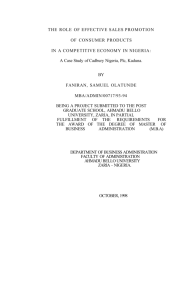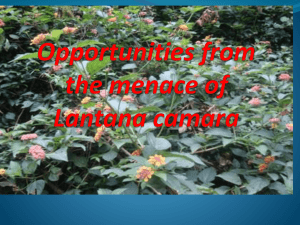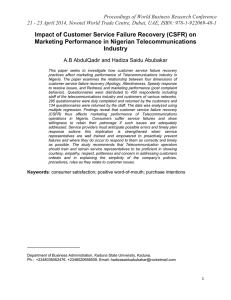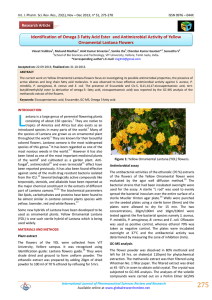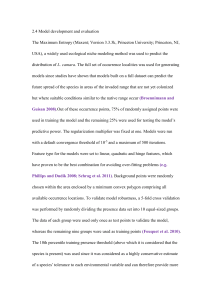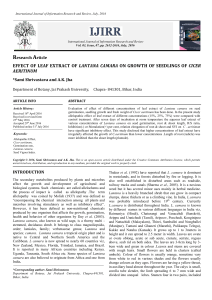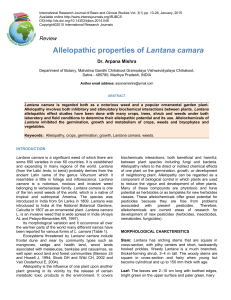British Journal of Pharmacology and Toxicology 4(4): 155-157, 2013
advertisement
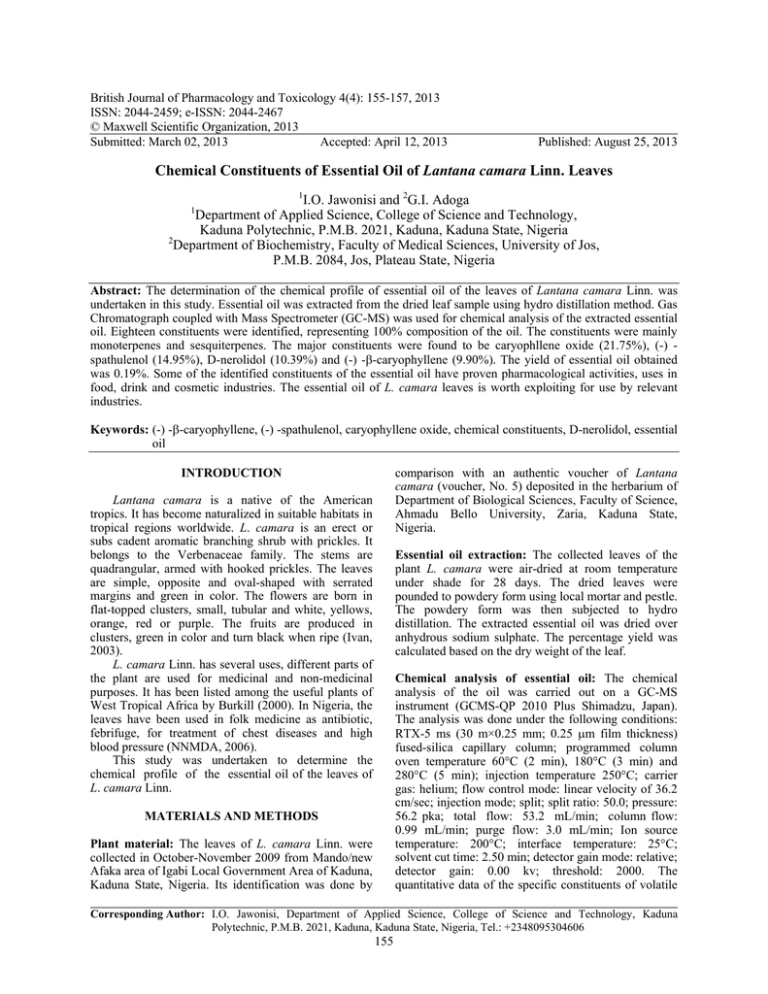
British Journal of Pharmacology and Toxicology 4(4): 155-157, 2013 ISSN: 2044-2459; e-ISSN: 2044-2467 © Maxwell Scientific Organization, 2013 Submitted: March 02, 2013 Accepted: April 12, 2013 Published: August 25, 2013 Chemical Constituents of Essential Oil of Lantana camara Linn. Leaves 1 I.O. Jawonisi and 2G.I. Adoga Department of Applied Science, College of Science and Technology, Kaduna Polytechnic, P.M.B. 2021, Kaduna, Kaduna State, Nigeria 2 Department of Biochemistry, Faculty of Medical Sciences, University of Jos, P.M.B. 2084, Jos, Plateau State, Nigeria 1 Abstract: The determination of the chemical profile of essential oil of the leaves of Lantana camara Linn. was undertaken in this study. Essential oil was extracted from the dried leaf sample using hydro distillation method. Gas Chromatograph coupled with Mass Spectrometer (GC-MS) was used for chemical analysis of the extracted essential oil. Eighteen constituents were identified, representing 100% composition of the oil. The constituents were mainly monoterpenes and sesquiterpenes. The major constituents were found to be caryophllene oxide (21.75%), (-) spathulenol (14.95%), D-nerolidol (10.39%) and (-) -β-caryophyllene (9.90%). The yield of essential oil obtained was 0.19%. Some of the identified constituents of the essential oil have proven pharmacological activities, uses in food, drink and cosmetic industries. The essential oil of L. camara leaves is worth exploiting for use by relevant industries. Keywords: (-) -β-caryophyllene, (-) -spathulenol, caryophyllene oxide, chemical constituents, D-nerolidol, essential oil comparison with an authentic voucher of Lantana camara (voucher, No. 5) deposited in the herbarium of Department of Biological Sciences, Faculty of Science, Ahmadu Bello University, Zaria, Kaduna State, Nigeria. INTRODUCTION Lantana camara is a native of the American tropics. It has become naturalized in suitable habitats in tropical regions worldwide. L. camara is an erect or subs cadent aromatic branching shrub with prickles. It belongs to the Verbenaceae family. The stems are quadrangular, armed with hooked prickles. The leaves are simple, opposite and oval-shaped with serrated margins and green in color. The flowers are born in flat-topped clusters, small, tubular and white, yellows, orange, red or purple. The fruits are produced in clusters, green in color and turn black when ripe (Ivan, 2003). L. camara Linn. has several uses, different parts of the plant are used for medicinal and non-medicinal purposes. It has been listed among the useful plants of West Tropical Africa by Burkill (2000). In Nigeria, the leaves have been used in folk medicine as antibiotic, febrifuge, for treatment of chest diseases and high blood pressure (NNMDA, 2006). This study was undertaken to determine the chemical profile of the essential oil of the leaves of L. camara Linn. Essential oil extraction: The collected leaves of the plant L. camara were air-dried at room temperature under shade for 28 days. The dried leaves were pounded to powdery form using local mortar and pestle. The powdery form was then subjected to hydro distillation. The extracted essential oil was dried over anhydrous sodium sulphate. The percentage yield was calculated based on the dry weight of the leaf. Chemical analysis of essential oil: The chemical analysis of the oil was carried out on a GC-MS instrument (GCMS-QP 2010 Plus Shimadzu, Japan). The analysis was done under the following conditions: RTX-5 ms (30 m×0.25 mm; 0.25 µm film thickness) fused-silica capillary column; programmed column oven temperature 60°C (2 min), 180°C (3 min) and 280°C (5 min); injection temperature 250°C; carrier gas: helium; flow control mode: linear velocity of 36.2 cm/sec; injection mode; split; split ratio: 50.0; pressure: 56.2 pka; total flow: 53.2 mL/min; column flow: 0.99 mL/min; purge flow: 3.0 mL/min; Ion source temperature: 200°C; interface temperature: 25°C; solvent cut time: 2.50 min; detector gain mode: relative; detector gain: 0.00 kv; threshold: 2000. The quantitative data of the specific constituents of volatile MATERIALS AND METHODS Plant material: The leaves of L. camara Linn. were collected in October-November 2009 from Mando/new Afaka area of Igabi Local Government Area of Kaduna, Kaduna State, Nigeria. Its identification was done by Corresponding Author: I.O. Jawonisi, Department of Applied Science, College of Science and Technology, Kaduna Polytechnic, P.M.B. 2021, Kaduna, Kaduna State, Nigeria, Tel.: +2348095304606 155 Br. J. Pharmacol. Toxicol., 4(4): 155-157, 2013 Fig. 1: Chromatogram of essential oil of the leaves of Lantana camara Linn. Table 1: Chemical composition and retention indices of the essential oil of Lantana camara Linn. leaves Peak number Retention indices (min) Constituents 1 8.371 Eucalyptol 2 8.502 Lilac alcohol 3 8.811 Lilac alcohol formate A 4 8.986 Cis-β-terpineol 5 9.496 Linalyl alcohol 6 10.324 Cis-verbenol 7 10.897 4-terpineol 8 11.082 ρ-menth-1-ene-8-ol 9 14.288 Copaene 10 14.430 Germacrene 11 14.938 (-) -β-caryophyllene 12 15.408 α-caryophyllene 13 15.822 Davana ether 14 16.251 1-naphthalenol 15 16.799 D-nerolidol 16 17.267 (-) -spathulenol 17 17.375 Caryophyllene oxide 18 17.809 α-pinene epoxide Composition (%) of total oil 0.78 0.82 0.51 0.79 1.57 0.37 0.90 1.42 3.87 1.16 9.90 5.89 8.92 6.94 10.39 14.95 21.75 9.07 oil were obtained by peak area normalization using a GC/FID. The identification of specific components was done by comparison of both mass spectra and GCretention data with authentic compounds previously analyzed and stored in the data system. Other identifications were carried out by comparison of the mass spectra with those existing in the data system libraries and cited in the literature (Adams, 2007; Mclafferty et al., 1974; NIST, 2005). (9.07%), davana ether (8.92%), 1-naphthalenol (6.94%), α-caryophyllene (5.89%) copaene (3.87%), linalyl alcohol (1.57%), ρ-meth-1-ene-8-ol (1.42%), germacrene (1.16%), 4-terpineol (0.90%), lilac alcohol (0.82%), cis-β-terpineol (0.79%), eucalyptol (0.78%), lilac alcohol formate A (0.51%) and cis-verbenol (0.37%) as shown in Table 1. RESULTS The serrated leaves of Lantana camara are aromatic and result has shown that they contain highly volatile oil. This oil is responsible for its essence. The extracted essential oil was bright yellow in color. A yield of 0.19% was obtained. The essential oil is composed of mainly monoterpenes and sesqiuterpenes. Eighteen compounds, representing 100% composition of oil were identified by GC-MS. The major components are oxygenated terpenoid; caryophllene oxide (21.75), (-) spathulenol (14.95% 0), D-nerolidol (10.39%) and a bicyclic sesquiterpene; (-) -β-caryophyllene (9.90%). DISCUSSION AND CONCLUSION The chemical analysis of the essential oil extracted from the dried leaf sample of Lantana camara Linn. used in this study was done using gas chromatograph and mass spectrometer (GCMS-QP 2010 plus Shimadzu, Japan). The yield obtained was 0.19%. The essential oil was bright yellow in color and highly volatile. Eighteen compounds were identified representing 100% of the oil (Fig. 1). The major components are caryophyllene oxide (21.75%), (-) spathulenol (14.95%), D-nerolidol (10.39%), (-) -βcaryophyllene (9.90%). Others are α-pinene epoxide 156 Br. J. Pharmacol. Toxicol., 4(4): 155-157, 2013 Caryophllene oxide has been reported as having analgesic, anti-inflammatory activity and antifungal activity against dermatophytes (Yang et al., 1999; Chavan et al., 2010). It is also well known as a preservative in food, drugs and cosmetics (Yang et al., 1999). Terpenes such as nerolidol, eucalyptol have been used as chemical enhancer to improve skin penetration for transdermal delivery of therapeutic drugs (Denise et al., 2005). D-nerolidol is also used as a food flavoring agent. (-) -β-Caryophyllene, a natural bicyclic sesquiterpene that is a constituent of many essential oil especially clove oil, rosemary, hops, among others (Ghelardini et al., 2001; Glenn, 1993). (-) -βcaryophyllene has been demonstrated to have antiinflammatory effects in mice (Gertsch et al., 2008). It is an FDA approved food additive and ingested daily with food. It is the first dietary cannabinoid. Spathulenol has an earthly-aromatic odor and a bitter herbal flavor. It has been found in various types of Artemisia (Juell, 1976). Spathulenol is used as fragrance and flavoring agents for drinks. α-Caryophyllene (α-humulene) is a naturally occurring monocyclic sesquiterpene found in essential oil of Humulus lupulus (hops) from which it derived its name (Glenn, 1993). The anti-inflammatory effects of α-humulene has been reported (Fernandes et al., 2007). α-Pinene oxide is used in fragrance industry. 1Naphthalenol (1-Naphthol) is a precursor to a variety of insecticides including carbaryl and pharmaceuticals including nadolol (Meeker et al., 2006; Gerald, 2005). Nadolol is a non-selective beta blocker used in the treatment of high blood pressure, migraine headaches and chest pain. Results from this study have shown that the essential oil of L. camara leaves contains compounds with proven pharmacological effects. The continued demand for preparation of synthetic flavorings and fragrances for use in pharmaceutical, food, drink and cosmetic industries makes the essential oil of L .camara worth exploiting for use by relevant industries. Chavan, M., P. Wakde and D. Shinde, 2010. Analgesic and anti-inflammatory activity of caryophyllene oxide from Annona Squamosa. Phytomedicine, 17(2): 149-151. Denise, C., L. Fabio, M. Alejandro and R. Solvia, 2005. Antileishmanial activity of the terpene nerolidol. Actomicrob. Agents Chemother., 49(5): 1679-1687. Fernandes, E., G. Passos, R. Medeiros, F. da Cunha, J. Ferreira, M. Campos, L. Pianowski and J. Calixto, 2007. Anti-inflammatory effects of compounds α-humulene and (-) -transCaryophllene isolated from essential oil of Cordia verbenacea. Eur. J. Pharmacol., 569(3): 228-236. Gerald, B., 2005. Naphthalene Derivatives. In: Ullmann’s Encyclopedia of Industral Chemistry. Wiley-VCH, Weinheim, pp: 628-630. Gertsch, J., M. Leonti, S. Raduner, I. Racz, J. Chen, X. Xie, K. Altmann, M. Karsak and A. Zimmer, 2008. Beta-caryophyllene is a dietary cannabinoid. Proceeding of the National Academy of Sciences of the United States of America, 105(26): 9099-104. Ghelardini, C., N. Galeotti, L. Dicesare, G. Mazzanti and A. Bartolini, 2001. Local anaesthetic activity of beta- caryophyllene. Farmco, 56: 387-389. Glenn, T., 1993. Hop Aroma and Flavor Brewing Techniques. Retrieved from: http://realber.com/ hops/aroma.html, (Accessed on: January 11, 2013). Ivan, R., 2003. Lantana camara. In: Medicinal Plants of the World: Chemical Constituents, Traditional and Modern Medicinal Uses. 2nd Edn., Humana Press Inc., Totowa, NJ, pp: 648, ISBN: 1592598870. Juell, S., 1976. New substances isolated from the essential oils of various Artemisia Specie: spathulenol, an azulenic sesquiterpene alcohol. Arch. Pharm., 309: 458-466. Mclafferty, F., R. Hertel and R. Villwock., 1974. Probability based matching of mass spectra: Rapid identification of compounds in mixtures. Org. Mass. Spectrom., 9(7): 690-702. Meeker, J., R. Louise, B. Dana and H. Ross, 2006. Exposure to nonpersistent insecticides and male reproductive hormones. Epidemiology, 17(1): 61-68. NIST (National Institute of Standards and Technology), 2005. Mass Spectral Library (NIST/EPA/NIH, v.2. Od). The NIST Mass Spectrometry Data Center, Gaithersburg. NNMDA (Nigeria Natural Medicine Development Agency), 2006. Verbenaceae. In: Okujagu, T.F. (Ed.), Medicinal Plants of Nigeria: North Central Zone. 1st Edn., Nigeria Natural Medicine Development Agency, Abuja, pp: 97. Yang, D., L. Michel, J. Chaumont and J. Millet-clerc, 1999. Use of caryophyllene oxide as antifungal agent in an in Vitro experimental model of onychomycosis. Mycopathologia, 148(2): 79-82. ACKNOWLEDGMENT Dr. Zakari Ladan of National Research Institute of Chemical Technology, Basawa, Zaria, Kaduna state, Nigeria is acknowledged for his contribution and technical assistance to this research study. REFERENCES Adams, R., 2007. Identification of Essential Oil Components by Gas Chromatography/ Quadrupole Mass Spectroscopy. Allured, Carol Stream. Burkill, H., 2000. Lantana camara Linn. In: The Useful Plants of West Tropical Africa. 2nd Edn., Vol. 5, Royal Botanica Gardens, Kew, pp: 258-260. 157
